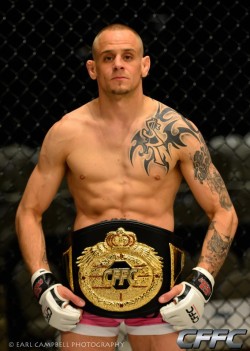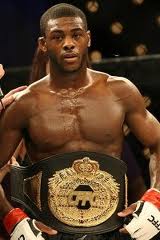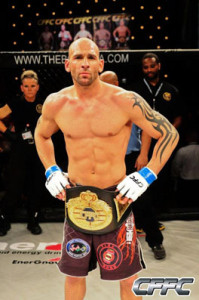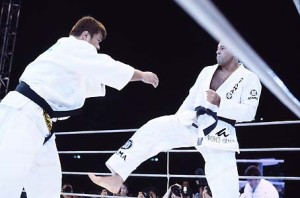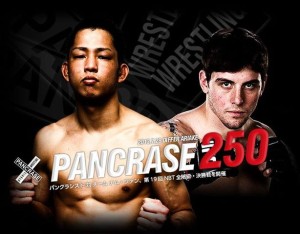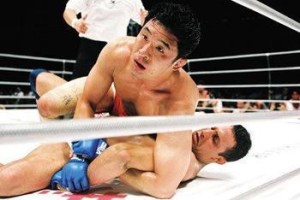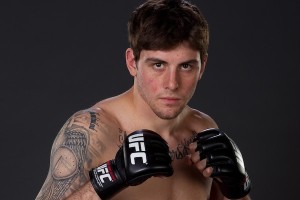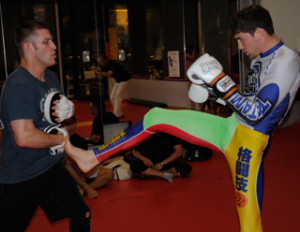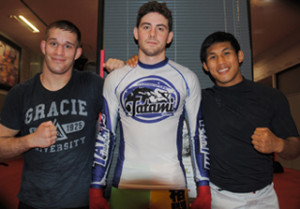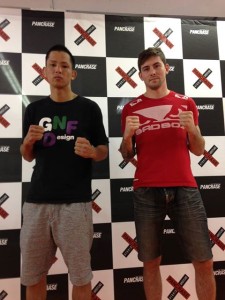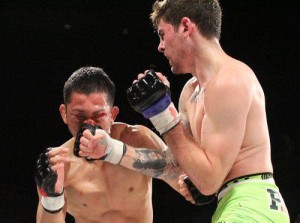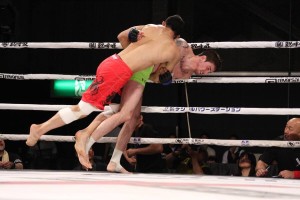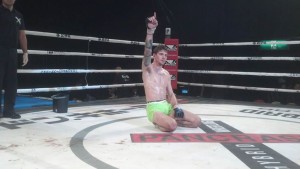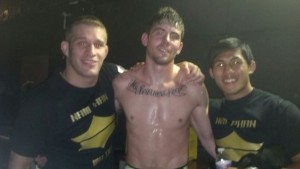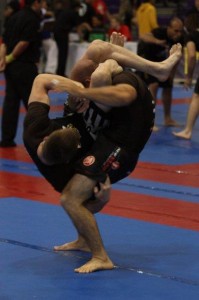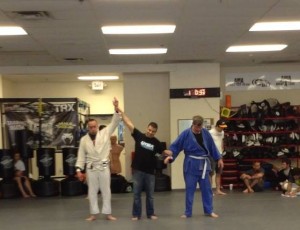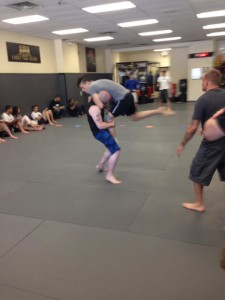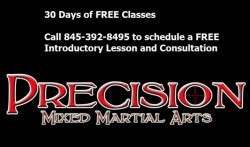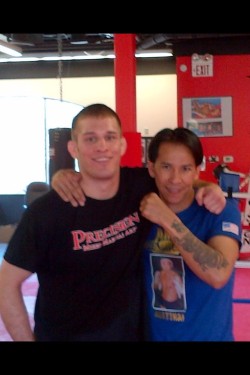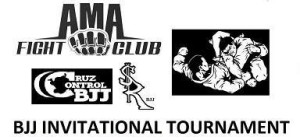A quick video from NAGA this past weekend where I got to hit one of my favorite techniques – the “Marcelotine”. For a step by step breakdown of the technique check out MMA Tampa coach Matt Arroyo’s (www.gracietampasouth.com) instructional HERE
5 Northeast Fighters The UFC Should Sign
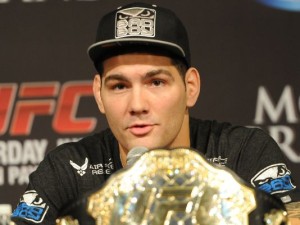 Pop quiz, what do Jon Jones, Chris Weidman and Frankie Edgar all have in common? Each of them started on the northeast MMA scene and went on to win UFC titles. I’m not sure if it’s the strong wrestling pedigree or the harsh winters that produces such tough fighters, but there’s certainly something in the water in the tri-state area. Now Joe Silva and Dana White have difficult jobs. They’re busy men with a lot on their plate. That is why I’ve decided to make their job easy and point out the future UFC superstars that are currently terrorizing the northeast MMA scene. I’ve been around this game for a while; I fought in Ring of Combat back when it was still in a ring. I’ve been punched by Lyman Good, choked by Jim Miller and thrown by Glover Teixeira – I know talent when I see it. So here are 5 fighters the UFC should sign immediately.
Pop quiz, what do Jon Jones, Chris Weidman and Frankie Edgar all have in common? Each of them started on the northeast MMA scene and went on to win UFC titles. I’m not sure if it’s the strong wrestling pedigree or the harsh winters that produces such tough fighters, but there’s certainly something in the water in the tri-state area. Now Joe Silva and Dana White have difficult jobs. They’re busy men with a lot on their plate. That is why I’ve decided to make their job easy and point out the future UFC superstars that are currently terrorizing the northeast MMA scene. I’ve been around this game for a while; I fought in Ring of Combat back when it was still in a ring. I’ve been punched by Lyman Good, choked by Jim Miller and thrown by Glover Teixeira – I know talent when I see it. So here are 5 fighters the UFC should sign immediately.
#1 – Sean Santella
Currently riding a 5 fight win streak which includes victories over Strikeforce and Bellator veterans, “Shorty Rock” has been striking fear in the hearts of 125-ers worldwide. With 9 of his 13 wins coming by way of submission, Shorty is a finisher and a crowd pleaser. Although known for his BJJ skills, Santella recently put his striking on display in a 5 round war with Evan Velez and proved that he knows how to fight on his feet. While defending his title at CFFC Santella has shown he can go hard for a full 5 rounds; a trait rarely seen among fighters outside the big shows. It’s been 3 ½ years since Santella suffered a defeat at flyweight and he has taken on all comers. A staple of the AMA Fight Club, Santella regularly trains with UFC veterans Charlie Brenneman, Jimmy Hettes and the infamous Miller brothers. The UFC also has an incredible human interest piece with Santella. He has overcome incredible odds in his quest for the UFC including a near career ending stroke following his professional debut. Santella is currently ranked in the top 20 flyweights in the world by every MMA publication, its time he got his shot inside the octagon.
#2 – Aljamain Sterling
At a perfect 7-0 Aljamain “Funk Master” Sterling is the 135-pound version of Jon Jones. Actually Sterling began training at Northeast powerhouse Bombsquad at the behest of Jones himself. Sterling is mainly known for his unpredictable striking and funk styled wrestling, but he recently demonstrated his submission skills by tapping out heralded BJJ Black Belt Sedico Honorio. At only 24 years of age Sterling is still progressing at a frenetic pace and shows all the signs of a future champion. The UFC would be wise to sign the Funk Master before a competing organization snatches up the young talent.
#3 – Nick Newell
9-0 with 8 finishes – all 8 of which have come in the first round. Newell has shown he can knock you out or submit you in the blink of an eye. In his debut for the World Series of Fighting Newell showcased spinning back elbows and lightning fast hands in addition to his solid wrestling and BJJ game. Newell has recently silenced critics who claimed he was not fighting top competition – his last two finishes came against opponents sporting records of 9-1 and 16-5 respectively. Newell has garnered some national press since he has accomplished all of this despite having a congenital amputation affecting his left arm. However, much like Jiu-Jitsu legend Jean Jacques Machado, Newell will be defined not by his physical limitations but by the extent of his accomplishments.
#4 – George Sullivan
“Scared to death, scared to look, they shook” the lyrics of Sullivan’s trademark entrance music aptly describes the demeanor of his opponents. Sullivan has been cutting through opponents like a hot knife through butter. Winner of 9 of his last 10, including a victory over UFC veteran Greg Soto and Ultimate Fighter vet Julian Lane, Sullivan has shown elite takedown defense and unstoppable power. A pupil of UFC veteran Kurt Pellegrino Sullivan has a quality camp behind him that can carry him to the big show. A big welterweight Sullivan has an intimidating cage presence and a no nonsense seek-and-destroy fighting style that will undoubtedly make him a fan favorite in the UFC.
#5 – Scott Heckman
 Entering his 20th professional bout powerhouse wrestler Scott “The Animal” Heckman is a seasoned veteran poised for big league MMA success. His last bout was a controversial loss in which a brutal eye poke was the main culprit which brought Heckman’s 7 fight win streak to a close. Heckman had a successful stint in Bellator where he showed composure under pressure. With only 2 of his 15 victories coming by way of decision Heckman has an uncanny ability to finish fights. Often taking on opponents who fail to make weight or are last minute replacements, Heckman has a reputation of taking on anyone, anywhere. Dana White has stated in the past that he wants real fighters and that is exactly what Scott Heckman is.
Entering his 20th professional bout powerhouse wrestler Scott “The Animal” Heckman is a seasoned veteran poised for big league MMA success. His last bout was a controversial loss in which a brutal eye poke was the main culprit which brought Heckman’s 7 fight win streak to a close. Heckman had a successful stint in Bellator where he showed composure under pressure. With only 2 of his 15 victories coming by way of decision Heckman has an uncanny ability to finish fights. Often taking on opponents who fail to make weight or are last minute replacements, Heckman has a reputation of taking on anyone, anywhere. Dana White has stated in the past that he wants real fighters and that is exactly what Scott Heckman is.
There you have it, the next patch of UFC superstars who call the northeast home. If the UFC is smart they’ll pick these fighters up quick before their price tags go up. Props to CFFC promoter Rob Haydak, 4 of the 5 fighters listed are currently fighting for his promotion. CFFC has shown a commitment to bringing in the top talent the northeast has to offer, hopefully the UFC will follow suit.
Interested in Hudson Valley MMA? Check out Precision MMA in LaGrange, NY visit http://www.poughkeepsiemixedmartialarts.com for a Free Trial
What if…
4 Ways the Gi Would Change MMA
By Jamey Bazes
The rules and regulations of the sport of Mixed Martial Arts have grown exponentially since the first Ultimate Fighting Championship took place back in November of 1993. Back in the early days of MMA, when it was generally referred to as either NHB (meaning “No Holds Barred”) or Vale Tudo (meaning anything “anything goes”) there were no weight classes, no time limits, no restrictions on the attire worn by the competitors, and only three rules: 1) no groin shots, 2) no eye gouging and 3) no biting. As the sport evolved more safety precautions were put into place. Over time, knees to the head of a grounded opponent, strikes to the back of the head, kicking the head of a downed opponent and downward elbow strikes were all banned. Wearing anything other than regulation shorts, cup, mouth piece and 4 ounce gloves was disallowed while Gis, T-shirts and shoes had previously been permitted, 8 weight classes were set into place and time limits were firmly established along with a number of other changes. We have even recently seen the entry of women into the UFC while only a few years ago president Dana White had said this would never happen. With the change of rules and format many bout outcomes have been altered from what they might have previously been. With the introduction of time limits, no longer is a bottom guard player allowed to wait all day long to secure a submission, so many Brazilian Jiu-Jitsu fighters do not have as much success as they did in the early days. Because of the prohibition of certain strikes, strikers have found their arsenals limited from what they once had, and perhaps some have had less success because of it. These changes in the sport are talked about with some frequency by MMA fans who have an interest in how the sport has adapted over time. However, one rule change which is not often discussed which has drastically changed the MMA landscape is the prohibition of the Gi in MMA, and MMA fans rarely consider how much this may have altered fight outcomes. I for one, believe that though many of the rule changes that have taken place in MMA have been positive, that there is room for more than one rule set in Mixed Martial Arts and that it would be both possible, and very interesting, to see MMA matches occasionally fought with the Gi on to see how different the results might be from current no-gi MMA. Afterall, sport Brazilian Jiu-Jitsu includes both Gi and No-Gi divisions, so why couldn’t the same be done in MMA? In this article, I will discuss 4 ways in which I think occasional Gi matches could change the outcome of MMA fights, and why I believe that it would not be ridiculous to introduce Gi divisions into modern day MMA.
Before going into the ways in which the introduction of the Gi could change the outcome of an MMA fight I would first like to address possible criticisms to this idea and my thoughts about how this concept could be put into practice without it hampering the positive changes which have already taken place in the sport. When discussing the concept of Gi-MMA fights with other MMA fans the first criticism that I usually get is that MMA fights fought with the Gi on would involve too much stalling due to the fighters excessively holding onto each other’s Gis. To this criticism my response is that the sport of MMA already has a great deal of stalling and that in certain ways wearing the Gi could actually prevent stalling, or at the very least, make it no worse than it already is. For one, lately we see an abundance of wrestlers in particular satisfied to score takedowns and then simply sit in an opponent’s guard without trying to pass while only landing minimal strikes and hoping for the decision. This tactic is often referred to as “lay and pray” by MMA fans. In my opinion, a Gi MMA match would decrease the incidents of “lay and pray” because fighters would have a much more difficult time sitting in top guard against skilled BJJ players who can use the Gi to attempt many submissions which are not possible in regular MMA, including Gi chokes and many types of submission set ups which utilize the Kimono. What I think we would see in a Gi MMA match, is fighters without expert submission defense being much more reluctant to go to the ground with top BJJ artists, and a much greater attempt to pass top guard once hitting the ground than we currently see due to the extra threats a bottom guard player would have. Because of this, I think the extra emphasis on either passing guard or staying off the ground in particular might lead to more submissions for the bottom guard player once hitting the ground, and also more knockouts in fights that might have otherwise gone to the ground where the wrestler or top game expert chooses to stand out of fear of the bottom game of his opponent. In all likely hood, I actually see the possibility of fights fought with the Gi on having a much greater percentage of finishes than we currently see.
A second criticism I hear to this idea is that there would be no fan base for MMA fought with the Gi on, but without any reason being given for why this would be so. I don’t have much to say to this criticism other than that the idea is entirely unfounded. Back when MMA allowed the Gi and different types of clothing it had its fans, and the Pride Fighting Championship also allowed the option of wearing the Gi and was at one time just as popular as the UFC.
Yet another criticism I hear to this idea is that people would see wearing the Gi in MMA as unnatural or strange and not want to watch because of that. To this comment I would respond with the following retort. I would first ask them why no-gi MMA fighting is natural in the first place. Lets face it; nearly all of the rules that have been put into place in modern day MMA are almost entirely arbitrary. A street fight in its’ essence has no rules to begin with, so any rule set is arbitrary. However, because MMA is not a street fight but rather a sport, it must include rules and whether or not the rules are appropriate is entirely subjective and dependent upon the commissions which preside over them. For example, there is no reason why knees to the head of a downed opponent are unnatural or necessarily any more dangerous than slamming an opponent directly on his head, which is allowed currently in MMA. Likewise, I cannot understand why strikes to the throat are still legal with the dangers they pose, or why upkicks from a bottom guard player to the head of a grounded opponent are illegal when they are probably no more dangerous than any head kick. All these rules are arbitrary, and so in my opinion is the restriction of wearing the Gi in MMA.
Finally, critics to this idea will state that there would need to be separate weight classes for fights fought with the Gi on, and that in particular, the UFC as the largest MMA org in the world would not have room on its roster for these separate divisions. To this I respond that it is most likely true that the UFC would not have space to accommodate all those extra fighters choosing to compete only with the Gi on, nor would they have the time on their cards to showcase these sorts of fights. However, they would most likely have the time and money to put an occasional “Gi-MMA” fight on a card, and I see no reason to believe that there would not be an audience for it. But the UFC is not the only MMA organization in the world. If the presiding commissions would agree to allow for Gi-MMA fights with very few rule differences from those set out in the Unified Rules we could see separate orgs rise to prominence with only Gi-MMA fights and the sport could grow on it’s own as a sub-genre of MMA with its own champions and weight classes. I see no reason why MMA needs to have only one rule set, and apparently, neither do the Japanese with their differing formats which allow fights to be fought with the Gi, as well as knees to the head of a downed opponent and several other rule differences from those used in the U.S.A.
So now that I have addressed the possible criticisms to allowing Gi-MMA fights to take place in the current landscape of the sport, let me address how the outcomes of fights might be different if fought with the Gi on and why these sorts of fights might be very interesting to watch as well as to compelling to compete under for current MMA fighters of different backgrounds. First of all, experts in arts which utilize Gi throws and takedowns such as Judo and Sambo would find much more success than they currently do. Right now the fighters who generally achieve the most takedowns in MMA come from wrestling backgrounds or from heavy cross training with wrestlers. However, if MMA was fought with the Kimono this might no longer be the case. Wrestlers and other sorts of takedown artists would have no answer to the specific tactics of Judokas and Sambo experts and would have to cross train in these styles. Also, the high amplitude throws utilized in Judo and Sambo which are less prominent without the Gi would probably be extremely entertaining for viewers. Many countries with top level Judokas would also become more involved in MMA as a whole and this could only add to MMA’s growth worldwide.
Another way in which the usage of the Gi would change the outcome of MMA fights is that there would be many more submission finishes overall. Gi chokes would become a common finish, which are of course impossible in modern MMA. However, almost all other submissions would probably become more common due to the extra grips and friction allowed by the Gi, as well as reduction of the sweat factor which allows fighters who are not necessarily all that skilled in submission defense to escape from decent submission attempts. Finishes by way of arm lock, leg lock, and chokes of all kinds would most likely rise in incidence, necessarily leading to more finishes in general and fewer decisions, which would please MMA fans in general. Also, holding dominant positions would become easier and we would likewise see more finishes by way of ground and pound and TKO.
This ties in to my next point which is that the guard position in general would become a more dangerous position to be in for the top fighter and for this reason opponents on top guard would be more likely to attempt guard passes. Because submissions and sweeps would become a much greater threat for the top guard player, fighters who might normally stall while on top in guard or half guard would be forced to attempt to pass to positions like sidemount and mount where they would not be in such danger against skilled submission artists. This would in turn lead to more submissions and sweeps for the bottom player because the attempted guard passes would leave the fighter on top vulnerable. It would also lead to more finishes for the top player who can successfully pass guard, because submissions and ground and pound are more effective from top positions like mount and sidemount than top guard.
Finally, because going to the ground in general would be a more dangerous proposition, especially against Brazilian Jiu-Jitsu experts with excellent guards, many fighters who would otherwise choose to grind out boring top control based decisions might choose to keep the fight standing and try to win using their striking. I think it is extremely likely that Gi MMA fights might include more striking than modern day MMA because of the extra threats of going to the ground, and in general the more casual fans as well as the die-hards tend to love a good stand up battle. All in all, I believe the incidence of finishes of one kind or another would go up exponentially with the Gi on, and in general MMA fans prefer to see a finish of one kind or another over a decision.
In summation, there is no reason to assume that MMA fought with the Gi could not thrive as a sub genre of MMA in the United States and worldwide. As already mentioned, there are a number of reasons why finishes by way of submission, KO and TKO might rise due to the unique circumstances created by the Gi, and we would most likely see an increase in exciting high amplitude Judo throws which would probably be greatly crowd pleasing. Fighters of different backgrounds would have more chance of success and really, the idea that MMA needs to be fought at all times under the rigid format that it currently has adopted is an arbitrary concept. If MMA has room for fights fought in both the cage and the ring, by both men and women and by fighters of all weights from flyweight through heavyweight, then I see no reason why it cannot have room for fights fought with the Gi on. Perhaps at some point some open minded athletic commissions and fight promoters will give this idea a shot and we can find out if the assertions made in this article are correct.
Jamey Bazes is a Hudson Valley MMA student at Precision Mixed Martial Arts. He holds a brown belt in Brazilian Jiu-Jitsu and is a lifelong martial artist.
Hello Japan!
Kids today don’t know how good they’ve got it. Yes, the closer I get to 30 the more of a grumpy curmudgeon I become, but in this instance I am one hundred percent correct. Fight master, Ultimate fighter, UFC on Fox, UFC on Fuel, FS1, UFC Unleashed, World Series of Fighting, Bellator, Inside MMA and if you’re really desperate you can always tune to the Spanish station and watch gladitorius del UFC – there’s almost too much MMA these days. Watching elite fighters put their skills on display is an everyday occurrence. However, once upon a time UFC events were pay per view only and often months apart. If you wanted to satiate your MMA desire you had to befriend a Direct TV subscriber and wait for the US broadcast of Pride Fighting Championships. In high school I would have been best friends with Charles Manson if it meant I could watch Kazushi Sakuraba fight Renzo Gracie.
Japanese MMA was special. Pride, Pancrase, K1 and Shooto all had a special flair. They were contested in pristine rings with over the top pageantry and showmanship. Mysterious international talent was coupled with wild rules, scoring and mixed weight super-fights. The silent crowd that appreciated submissions as much as striking was also a welcome alternative to the inebriated “just bleed” crowd that populated American MMA events.
Fighting in Japan was a dream of mine. During my MMA career I scratched off plenty of bucket list items. I fought for Zuffa, made it to the Ultimate Fighter and won a few oversized MMA belts – but I never made it to the Land of the Rising Sun.
Fortune smiled on me though after sparring at the AMA Fight Club on day when my friend Andy Main shared some exciting news. “I’m fighting in Japan” Andy said with his trademark calm demeanor. Without hesitation I told him, “If you fight, I’m there”. Finally, the opportunity to experience Japanese MMA first hand had arrived and in Pancrase no less. Anyone with an appreciation for MMA history knows the esteem place Pancrase holds in the mixed martial arts world – an event that pre-dates the UFC and launched the careers of pioneers like Bas Rutten, the Shamrock brothers, Yuki Kondo and Matt Hume.
Andy Main was slated to take on Hiroki “AB” Aoki as part of Team Nam Phan vs Team Pancrase. Originally a number of fighters were slated to represent Nam Phan, but through a process of attrition Andy became the sole representative for Nam. Andy and Nam knew each other as teammates on season 12 of The Ultimate Fighter. Andy has been the best kept secret in northeast MMA for the past few years. A slick fighter giving top UFC fighters fits in training who ran into a bad streak of illness and injuries. Andy would prep for a fight when shingles, mono, flu or vitamin deficiencies would strike – if there was an illness Andy had it. I used to joke that I knew cancer patients healthier than him. Lately though, it seemed like he had turned a corner. He climbed back into the cage for CFFC and put on a clinic en route to a first round submission victory. His striking had caught up to his jiu-jitsu and he was looking dangerous in all areas.
His opponent was tricky. Aside from having to travel behind enemy lines, the fight was also going to be contested at 155, one weight class above Andy’s normal fighting weight. For the first time he wasn’t going to have the height advantage either as his opponent was long and lean. Experience also played into AB’s favor with him having more than twice as many fights as Andy. If any of this bothered Andy you’d never know it. He put his nose to the grind stone and whenever the topic of Pancrase came up he spoke with an assertive confidence that let me know he expected to walk away with his hand raised.
The only stumbling block seemed to be the fact that the fight would be contested inside a boxing ring as opposed to a cage. Most of our training at AMA Fight Club prepares us for walls and cages rather than ropes. Fortunately, my Hudson Valley MMA gym Precision Mixed Martial Arts has a full sized boxing ring. Andy made weekly trips up to Poughkeepsie, NY to familiarize himself with the ring and pick up some coaching tips from me at the same time. As a student Andy is ideal. He’s receptive to feedback and constructive criticism and makes better mid-round adjustments than almost any fighter I’ve worked with. While coaching him at times I almost felt like I was playing a video game and he was my character.
Finally, camp came to a close and it was time to fly out. I extended my stay longer so I would get some extra training (put the $1,800 plane ticket to good use). After Andy arrived we met in Shinigawa decided it would be good to get a sweat going after being cooped up in a plane for 14 hours. On way to the local Gold’s Gym we got our first taste of Japanese culture shock. Andy is something of a boy scout. He’s a vegetarian; he grew up doing mission work for his local church and runs a business with his little brother. You’re more likely to find him at a dog park than a bar. However, he is covered in tattoos. His most prominent ones are portraits of his mother and father and an inscription reminding him that he is his brother’s keeper. Not exactly skulls and cross bones. However, once the woman behind the counter saw the slightest bit of ink peeking out from the sleeve of his sweat shirt she treated him like he was in the Hell’s Angels. She insisted we leave immediately. After a series of begging and pleading (90% of which was likely lost in translation) we were allowed to stay. Apparently, every Gold’s Gym in Tokyo comes equipped with a fully stocked MMA gym. We got a good workout in and I could feel that in spite of the arduous journey Andy retained his strength.
The following afternoon was open workouts and media day. We met Nam Phan and headed over to a different Gold’s Gym to get some training in. We reviewed some last minute technical strategies and got after it hard. Andy was feeling stronger today and it showed. Once Andy was finished training I got some good flow rolling in with Nam and was impressed. He even showed me a few tips for landing his signature liver shot. It’s too bad we didn’t have more time to train together. The Japanese media was interesting. They were always looking at things from a pro-wrestling angle, trying to stir the pot and get Andy to say something controversial that would fire up the opposition. We were able to find out that everyone had painted Andy as a pure jiu-jitsu fighter. We were excited since striking was a big part of our game plan, we figured the element of surprise would be on our side.
Weight cutting wasn’t going to be an issue. Andy was walking at 155 despite eating regularly. We knew we would be giving up size, but stereotypically the Japanese aren’t big weight cutters so we weren’t too concerned.
The weigh-ins were supposed to be a non-issue, but became more dramatic during the rules meeting. Going into this fight we were under the impression that it would basically be contested under unified rules sans elbows. We quickly found out that we were mistaken. Each time we spoke to someone the rules changed. By the time we were done asking soccer kicks, stomps and knees to a grounded fighter were all legal – it was like old school Pride rules. Fighting for sport is something of a chaotic endeavor. The one thing I try to do as a coach and athlete to mitigate the chaos is to be aware of all the variables and prepare my athletes accordingly. These last minute revelations did not sit well with me. I started going over new strategies and frantically trying to make sense of the new potential dangers we faced in the fight. Andy shared none of my concerns. He looked at me and said “Whatever, it’s a fight”. I wasn’t sure if his resolve was the result of confidence or insanity, but it let me know he was dialed in and nothing was going to change that.
The weigh-ins also saw drama when fellow US fighter Amber Brown struggled to cut the final pounds in order to make her 105 lbs. weight class. Seeing how lean and dry she appeared I wasn’t certain she could do it. Simply walking up a small hill on way to the scale was a tall order for Amber, but there was a lot of resolve in her small frame and she made the weight.
Following some epic meals, sight-seeing and wandering it was game day. Unlike cards in the US which might have 10 or so bouts, Pancrase had stacked 18 fights on the card with Andy being the main event, which meant a whole lot of waiting. As the bout neared closer I noticed a few things that were different in Japan. No one watched me while I wrapped Andy’s hands, a process that is traditionally very closely scrutinized by US athletic commissions. Also, none of the fighters were drug tested. In the US something as pedestrian as a sleeping pill can result in a failed drug test and hefty fines. There was no pre-fight physical or doctor exam. Finally, no Vaseline was applied prior to fights and there were seemingly no cut men in the corners. Many of these rituals are never noted by the casual observer, but for me the absence of these pre-fight traditions made me feel like I was in the Wild West.
After a quick warmup it we stepped into the on-deck circle. Nam and I peeked our heads around the curtain to watch Amber’s fight. We got to know Amber a little in the days prior and were really rooting for her. Things weren’t looking good, she was eating hard leg kicks and had a cut bleeding right over her eye. She rallied in the second round, but was clearly not going to be winning a decision. Time was ticking away with Amber on her back when she threw up a perfect armbar from guard. She put everything into it and scored the submission. Amber’s victory gave us some positive energy to fuel off and I suddenly felt more at ease as the pre-fight promos played for Andy’s fight. There was a long pro-wrestling-esque montage that set the stage for Andy vs AB. Finally Andy’s entrance music played and it was go time. Andy (and his brother Mikey, a fighter himself) walk out to “Some Nights” by Fun. The song is a light hearted sing along track. It helps break some of the tension and anxiety surrounding the imminent battle. AB destroyed this calm ambiance by walking out to the most abrasive screaming death metal I’ve ever heard in my life. The juxtaposition was borderline comical.
Immediately prior to the walkout a new wrinkle immerged when officials told Nam and I that the fight would feature “open scoring”. Meaning that judges would indicate who was winning at the conclusion of each round. I decided not to tell Andy about this new discovery since I didn’t want to break his concentration just prior to fighting.
At long last, the bell sounded and round 1 began. Andy began executing the game plan to a “t”. He marched out, controlled the center and began lacing AB with lightning quick jabs and crosses. Each punch was snapping AB’s head back. Andy was being mindful of his defense keeping his head moving the whole time, being aggressive by not wreck less. AB decided to abandon the striking exchange and moved into the clinch. I could tell he was strong here, but Andy was controlling well with his wizzer. AB made a quick move to Andy’s back and secured hooks for a brief moment, but Andy countered with a Sakuraba like Kimura and turned into the guard. Now ontop Andy worked some ground and pound and looked to pass after thwarting a few upkicks. Taking side control Andy landed some knees to the body before the round closed.
The fight was going perfect, Andy had rocked AB who was now cut and clearly won the round. I told Andy to use and underhook rather than a wizzer to stop AB from coming behind him and to mix some uppercuts into his combinations since AB was looking down to avoid the 1-2’s.
Round 2 began and Andy once again dominated the boxing. He mixed in the uppercuts perfectly and followed them up with huge knees. AB clinched in desperation and Andy pummeled to an underhook and hit a flawless Uchi Mata sending his opponent head over heels crashing to the mat. I thought Andy might just finish the fight here, but AB showed this would be no easy victory by attacking off his back. AB locked in a triangle that had me heart skip a beat, Andy defended well by posturing but found himself in a kimura quickly thereafter. I was confident that the submission wouldn’t be finished, but worried that if the round ended this way they would award it to AB. Andy solved the riddle though and escaped to side control and then immediately mounted. With 15 seconds we told him to pull the trigger and he finished the round raining down strong punches. We were now up 2 rounds to 0.
Going into the 3rd I just wanted Andy to stay out of the clinch. We knew he could knock AB out if he made it a striking battle. I could tell Andy was fatigued, but far from gassed. The third round began much like the prior two with Andy landing clean strikes almost at will. Right as a knockout seemed imminent the ref called a halt to the action to check AB’s cut. Initially I thought this would benefit us since Andy could catch his breath, but the break was so long that it really allowed AB to recover and get back in the fight. AB pushed forward and secured a body lock. He hit a bear hug and landed on top of Andy. As Andy went to shrimp AB took his back and locked in a tight body triangle. Andy defended well, but wasn’t able to move his hips out to escape. Time was on our side though, if we could simply survive the next 2 minutes we would take home a victory. At one point AB had him completely flattened out and things looked bad, but Andy showed his heart and gutted out an escape. To his credit AB landed some shots before Andy secured closed guard, but once he did he immediately threw up a tight armbar, AB defended well and the round came to a close. The open scoring allowed us to breathe a sigh of relief during the announcement – Andy earned the decision.
Nam and I went crazy and ran to congratulate Andy, who was on the verge of throwing up. Fortunately, he was able to hold it together, but he told us he had pulled something in his rib which is why the final round was so dramatic. After a few pictures and autographs we headed back to the locker room victorious.
Following the fight Andy posted this:
“Now the thank you’s! HUGE thank you to my coach and training partner Brian McLaughlin for making the trip to Japan with me and preparing me for this fight. Big thanks to Nam Phan for setting it up. Thanks to everyone at Pancrase for giving me the opportunity. Thank you Coach Mike Constantino and all my teammates at AMA Fight Club, I will be back asap to help you all get ready for your next bouts. Also the guys at Precision MMA and my Instructor Yanni Hronakis for helping me prepare. Thank you to my students and family at Pure MMA you guys don’t realize what you all mean to me. Thank you Alex Kennedy and Melvis Figueroa for helping cover classes while I was away. Thank you my Mom and Pop for the ongoing support. Thank you to my amazing supportive girlfriend Maggie Krol. And thank you to my brother Mikey who keeps me honest and keeps me pushing forward whether he knows it or not. I fight for you all and it makes victory that much sweeter”
Interested in becoming the next Hudson Valley MMA champion? Check out Precision MMA FREE for 30 days call 845-392-8495 or visit http://www.poughkeepsiemixedmartialarts.com
Triangle Chokes!
Here’s a post I did for BJJ.org where I showed all my favorite triangle chokes
Enjoy!
Precision students shine at AMA Fight Club Tournament – Hudson Valley martial arts
A handful of Precision MMA students made the trip from their Hudson Valley martial arts gym in LaGrange, NY down to Whippany, NJ for the American Martial Arts Invitational Tournament.
The tournament was well run and everyone had fun competing amongst friends. Big victories were earned by Erik Andren, Johnny Miranda, Andrew Colombos and Mike Crawford. I have mixed feelings about tournament jiu-jitsu. On the one hand competition has many positive martial arts benefits. It forces the student to call upon their skills in any unfamiliar environment against an opponent who is offering up 100% resistance. Often times this will highlight technical mistakes and give the student a more realistic view of how their body will operate under stress. For many, the stress of competition is the closest to a simulated street fight. Also, competition can motivate a student to strive for higher achievement and lead to them making positive life changes such as improving their diet, losing weight or simply making martial arts a greater priority. The thrill of victory can snap people out of their complacency in training and force them to take a more critical look at their practice routines.
However, there are a number of drawbacks to tournament centered jiu-jitsu. Jiu-jitsu is supposed to be the weak man’s art. A gentle style that uses yielding and pliancy to overcome strength and power. Minimum effort for maximum result is the beauty of jiu-jitsu. In order for someone to properly harness the power of jiu-jitsu they cannot force things on their adversary, but be patient and weight for opportunities. They must utilize timing to displace their opponent rather than powering through. However, with an artificial time limit competitors are pushed into forcing things, making things happen rather than allowing them to occur organically. Also they are made to use as much of their energy and effort as possible rather than conserving and using the minimum necessary to be safe.
Another drawback is the mindset of tournament jiu-jitsu. Tournament competitors must train to be bigger, faster and stronger than their opponents. However, I teach my students to always assume they have an attribute disadvantage. Do not try to match speed or strength, but rather find the path of least resistance. The calculating gentle style of jiu-jitsu may result in being placed in inferior position and giving away “points” but it means they will not succumb to fatigue or make a careless mistake. Real fights could last indefinitely in theory therefore a self defense minded practitioner must conserve. The Gracie philosophy of not moving faster than your opponent, but exhausting more slowly than them. This training methodology will not necessarily lead to success in a points based system. Tournament jiu-jitsu, in my estimation, breeds athletes more so than martial artists.
Finally, the “safety first” mindset of self defense is often lost in the tournament approach. Students embrace positions in sport settings that would get them in hot water for self defense. For example, sport guard passers standing bent over leading with their heads is asking to be kicked in the face, however it can be very successful for tournament jiu-jitsu. Students jumping to their backs rather than looking for a takedown and top position is perfectly fine for tournaments, but disastrous if fighting an opponent on an unforgiving surface in real life.
In a way my musings about competition centered training is hypocritical since I was an avid competitor for a considerable amount of time and my competition accolades are often what draws people to my schools. However, I never forget that the reason I started training martial arts was to defend myself when I was a weak and frightened teenager. I looked to jiu-jistu because I was certain it could allow me to survive an attack against someone bigger, faster and stronger and that power is worth more than any tournament medal.
Interested in training Hudson Valley martial arts? Check out Precision MMA in LaGrange, NY call 845-392-8495 or visit http://www.poughkeepsiemixedmartialarts.com
Spider Guard Omoplata – Hudson Valley martial arts
Here’s a cool move from the spider guard which allows you to transition into an omo plata or a triangle. Filmed at my Hudson Valley martial arts school Precision MMA in LaGrange, NY.
Brought to you by http://www.learntograpple.com your source for Hudson Valley martial arts techniques
Hudson Valley Martial Arts, Spider Guard Bicep Lock
Check out the latest from www.learntograpple.com the best source for Hudson Valley martial arts techniques
Want to train Hudson Valley martial arts for 30 Days Free check out http://www.poughkeepsiemixedmartialarts.com or call 845-392-8495
Precision MMA Students Travel to Compete
Hudson Valley martial arts competitors will invade Whippany New Jersey for the AMA Invitational Brazilian Jiu-Jitsu tournament tomorrow. Garden State bragging rites are on the line!

